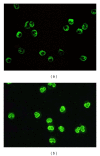Novel clinical and diagnostic aspects of antineutrophil cytoplasmic antibodies
- PMID: 24995343
- PMCID: PMC4068101
- DOI: 10.1155/2014/185416
Novel clinical and diagnostic aspects of antineutrophil cytoplasmic antibodies
Abstract
Antineutrophil cytoplasmic antibodies (ANCA) are the serological hallmark of some idiopathic systemic vasculitides. Besides the investigation of ANCA-associated vasculitis (AAV) and constant effort for a standardized nomenclature and classification of the AAV, a main focus of research during the last few years has been to constantly improve the performance of enzyme immunoassays. With the latest so called third generation ELISA, this goal seemed to be fulfilled. The International Consensus Statement on Testing and Reporting of ANCA gave recommendations for standardized strategies for the serological diagnosis of ANCA. New developments now target the system immanent drawbacks of the respective diagnostic methods, be it the need for batching and the long time to result for ELISA, or the high likelihood of error and subjectivity of indirect immunofluorescence (IIF). Random access technology and multiplexing for solid phase assays as well as digital imaging for IIF are tools which may help to expedite and simplify routine diagnostics in the lab and in emergency settings. Recent findings indicate that PR3-ANCA have clinical utility beyond the diagnosis of AAV. PR3-ANCA can also serve as an aid for the differentiation between ulcerative colitis (UC) and Crohn's disease (CrD) and the stratification of UC patients. This review provides a detailed review of what is known about ANCA and highlights the latest research and state-of-the-art developments in this area.
Figures







References
-
- Radice A, Sinico RA. Antineutrophil cytoplasmic antibodies (ANCA) Autoimmunity. 2005;38(1):93–103. - PubMed
-
- Wiik A. Delineation of a standard procedure for indirect immunofluorescence detection of ANCA. APMIS, Supplement. 1989;97(6):12–13. - PubMed
-
- van der Woude FJ, Rasmussen N, Lobatto S. Autoantibodies against neutrophils and monocytes: tool for diagnosis and marker of disease activity in Wegener’s granulomatosis. The Lancet. 1985;1(8426):425–429. - PubMed
-
- Falk RJ, Jennette JC. Anti-neutrophil cytoplasmic autoantibodies with specificity for myeloperoxidase in patients with systemic vasculitis and idiopathic necrotizing and crescentic glomerulonephritis. The New England Journal of Medicine. 1988;318(25):1651–1657. - PubMed
Publication types
MeSH terms
Substances
LinkOut - more resources
Full Text Sources
Other Literature Sources
Miscellaneous

